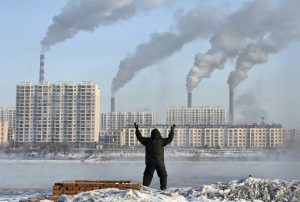The Looming Threat
Lack of access to information on levels of different air pollutants and their sources is dangerously limiting policy development world over to improve air quality…..
By Dr Manisha Yadav

Worldwide 3.7 million premature deaths were attributable to ambient air pollution in 2012. About 88% of these deaths occurred in low and middle income countries. The regional breakdown (low and middle income countries) is: The Western Pacific: 1,670,000 deaths, South East Asians regions: 936,000 deaths, Eastern Mediterranean region: 236,000 deaths, Europe 203,000 deaths, Africa: 1, 76,000 deaths, Americas: 58,000 deaths. The regional breakdown for high income countries: Europe 279, 000 deaths, Americas 94,000 deaths, Western Pacific: 68,000 deaths, Eastern Mediterranean countries: 14 000 deaths.
The WHO maintains a worldwide, public database on urban outdoor air pollution in its Global Health Observatory. The database contains measured outdoor air pollution levels of PM2.5 and PM10 from 1100 cities in 92 countries for the years 2003-2010. These are used for estimating mean annual exposures of the urban population to fine particulate matter. In 2013, the WHO began collaborating with major institutions and agencies worldwide in the development of a global air pollution platform that includes data on air pollution concentrations based on satellite monitoring, chemical transport models and ground measurements, inventories of pollution emissions from key sources, and models of air pollution drift – permitting estimates of air pollution exposures even in areas where there are no ground level monitoring stations.
WHO’s main function is to identify and monitor those air pollutants with the greatest impact on people’s health. This helps the WHO Member States to focus their actions on the most effective way to prevent, or reduce health risks. WHO’s task is to review and analyze the accumulated scientific evidence, and use expert advice to draw conclusions on how much different air pollutants affect health as well as identify effective measures to reduce the air pollution burden.
Governments can identify their main sources of ambient air pollution, and implement policies known to improve air quality, such as: promotion of public transport, walking, and cycling (rather than transport relying on private motor vehicles); promotion of power plants that use clean and renewable fuels (e.g. not coal), and improvements in the energy efficiency of homes, commercial buildings and manufacturing.
Essential accompanying steps include increasing awareness about the high disease burden from ambient air pollution and its main sources, as well as highlighting the importance of taking action now to implement country-specific interventions. In addition, the use of effective monitoring to evaluate and communicate the impact of interventions is also an important tool in raising awareness. It can help drive policy action that brings benefits for health, climate and the environment.
WHO estimates that 12.7% of deaths could be averted by improving air quality worldwide. Lower levels of air pollution will reduce the burden of respiratory and cardiovascular disease-related illnesses, health-care costs, and lost worker productivity due to illness, as well as increasing life expectancy among local populations. In addition, actions that reduce ambient air pollution will also cut emissions of short-lived climate pollutants, particularly black carbon which is a major component of soot emissions from diesel vehicles, and other sources, as well as greenhouse gases (CO2) contributing to longer-term climate change impacts.
Climate change produces a number of adverse effects on health. This includes those from drought and extreme weather events (e.g. windstorms, floods), such as water-borne and food-borne diseases. It also increases the prevalence of vector-borne diseases like dengue or malaria.

Here it is matter of debate over what challenges do countries face, and what obstacles are preventing assistance in improving ambient air quality? Enough knowledge exists internationally about the health effects of ambient air pollution but what often can limit policy development for the improvement of air quality, is the lack of access to information on levels of air pollutants and their main sources of pollutants.
There is also often a lack of awareness about the health burden of ambient air pollution. This can be due to little awareness of the international evidence from both developed and developing countries linking ambient air pollution exposure and health, or due to a gap in information from air quality monitoring, or even due to an under-appreciation of the potential solutions and measures that can be taken to improve air quality.
Improving ambient air pollution is an inter-sectoral challenge. Improving air quality should be an important consideration in policy planning across different economic sectors (e.g. transport, energy, industry, urban development) to ensure the greatest benefits for health. In addition, there is significant inequality in the exposure to air pollution and the related health risk: air pollution combines with other aspects of the social and physical environment, creating disproportional disease burden in populations with limited incomes and with minimal local resources to take action. “
Exposure estimates for ambient air pollution are based on a global model using all available surface monitoring data, atmospheric transport models and satellite observations. One of the advantages of this approach is an ability to estimate risks in countries with no, or little, locally collected data. Exposure distributions produced by such models for larger regions agree well with the distributions from surface observations and are more reliable than estimates for smaller ones.
All studies are observational and very few have measured exposure directly. As a result, risk estimates are poorly quantified and may be biased. Exposure to indoor air pollution may be responsible for nearly 2 million excess deaths in developing countries and for some four percent of the global burden of disease.
(The author is Medical Practitioner, New Delhi)

